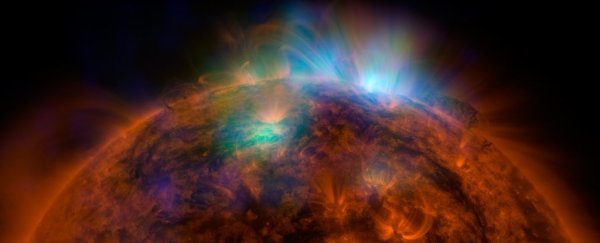Earth is our Solar System's bluest planet, and yet no one really knows where all our water came from.
The dust of a nearby asteroid has now revealed a potentially overlooked source: the Sun.
Some water on our planet, it seems, might have been created by a river of charged particles, blown from the upper atmosphere of the Sun billions of years ago.
When solar wind interacts with the tiny dust particles found on certain asteroids, it can create a small amount of water, and this could explain some of the liquid we find here on our planet.
Most modern models suggest the majority of H20 on Earth originally came from an extraterrestrial source, possibly from C-type asteroids in the Jupiter- Saturn region and beyond.
These far-away asteroids are thought to be the parent bodies of carbonaceous chondrite meteorites that regularly crash into Earth, and this particular type of meteorite is known to contain a significant amount of water-containing minerals.
But carbonaceous chondrites probably aren't the only way water was initially delivered to Earth. Other types of water-rich meteorites could have also done the same, especially since carbonaceous chondrites can't account for Earth's entire water budget.
There are other types of chondrite asteroids that could have also held particles of water, albeit to a lesser extent. The near-Earth asteroid, Itokawa, for instance, is an ordinary chondrite asteroid, and an analysis of samples taken from this silicate-rich rock in 2010 found signs of water, and the source could very well be the Sun.
Solar wind irradiation has been proposed in the past as a possible way to form water on silicate-rich materials floating in space.
In the lab, volatile hydrogen ions have been shown to react with silicate minerals, resulting in water as a byproduct, and electron microscopy and electron spectroscopy studies have found direct evidence of H20 within extraterrestrial dust particles in the past.
Theoretically, if water becomes trapped in these dust particles, the element will be protected from space weathering and can then be delivered via meteorites to other bodies in space.
"This phenomenon could explain why the regoliths of airless worlds such as the Moon, which were once thought to be anhydrous, contain several percent H20," the authors of the new study explain.
To explore this hypothesis further and in a slightly different way, researchers turned to the S-type asteroid, Itokawa, to see if this object contains a 'volatile reservoir' of isotypes similar to that of solar wind.
While most water isotypes on Earth match carbonaceous chondrites, a small percentage don't, and the Sun or the solar nebula have been proposed as possible sources.
Drawing on a meticulous atom-by-atom analysis, known as atom probe tomography, scientists have now measured the abundance of water found within dust from the Itokawa asteroid, which was returned to Earth by the Japanese Aerospace Exploration Agency (JAXA) in 2011.
Measuring all around these particles, including the parts hidden from the Sun, the team found hydroxide and water enriched in the rims on all sides. This suggests the Sun's hydrogen ions were 'implanted' into the rock, storing water where it can't be touched.
The depth at which these life-giving elements were found was exactly what scientists would expect from hydrogen ions penetrating silicate materials.
"Our research suggests the solar wind created water on the surface of tiny dust grains and this isotopically lighter water likely provided the remainder of the Earth's water," says planetary scientist Phil Bland from Curtin University in Australia.
Judging from how much water they found in these tiny dust particles, the team estimates S-type asteroids can hold 20 liters of H20 for every cubic meter of rock.
The findings suggest isolated grains of dust in space could represent an important source of water in our Solar System – one which we could potentially harvest in the future if we collect enough of them.
"How astronauts would get sufficient water, without carrying supplies, is one of the barriers of future space exploration," says geoscientist Luke Daly, who worked on the analysis while at Curtin University.
"Our research shows that the same space weathering process which created water on Itokawa likely occurred on other airless planets, meaning astronauts may be able to process fresh supplies of water straight from the dust on a planet's surface, such as the Moon."
The Sun could be giving us life in more ways than one.
The study was published in Nature Astronomy.
